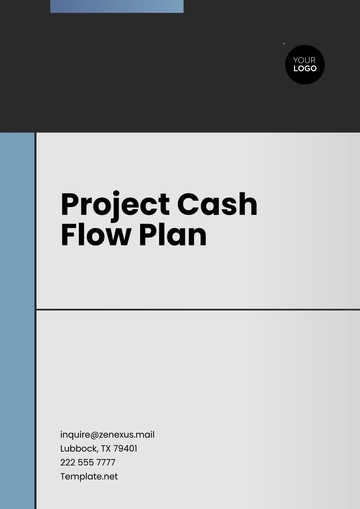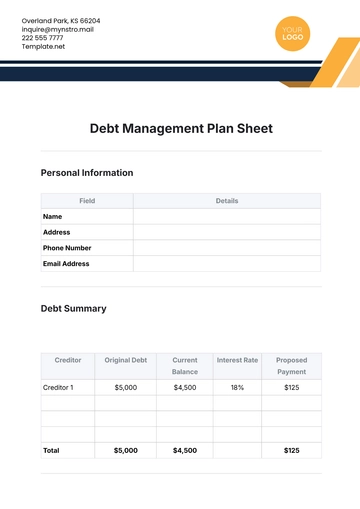Free Agriculture Financial Management Plan

I. Introduction
A. Purpose of the Plan
The primary purpose of this Agriculture Financial Management Plan is to outline a systematic approach to managing the financial resources of [Your Company Name]'s agricultural operations. It aims to enhance the financial health of the business, ensuring long-term sustainability and profitability. This plan serves as a roadmap for making informed financial decisions that align with the company's strategic goals.
B. Scope and Objectives
The scope of this plan encompasses all financial activities within [Your Company Name]'s agricultural operations, including revenue generation, expense management, budgeting, cash flow management, risk assessment, and financial performance analysis. The key objectives are to:
Establish clear financial goals and strategies.
Develop and monitor budgets to control costs and optimize revenue.
Ensure efficient cash flow management to support operational needs.
Identify and mitigate financial risks.
Evaluate financial performance through regular analysis and reporting.
C. Importance of Financial Management in Agriculture
Effective financial management is crucial for the success of any agricultural business. It helps in maintaining financial stability, ensuring the availability of funds for operational needs, and making strategic investments for growth. In agriculture, where revenues can be highly variable due to factors like weather conditions and market prices, robust financial management practices are essential to navigate these uncertainties and achieve long-term sustainability.
II. Financial Planning
A. Setting Financial Goals
Financial planning begins with setting clear, achievable financial goals. For [Your Company Name], these goals may include increasing profitability, reducing costs, expanding production capacity, and improving cash reserves. Setting specific, measurable, attainable, relevant, and time-bound (SMART) goals provides a clear direction for financial activities and helps in tracking progress.
B. Developing a Financial Strategy
A well-defined financial strategy is essential for achieving the set goals. This strategy should consider the unique aspects of [Your Company Name]'s agricultural operations, including crop and livestock production cycles, market trends, and potential risks. The strategy should outline how the company plans to generate revenue, control costs, manage investments, and allocate resources efficiently.
C. Long-term vs. Short-term Planning
Financial planning should balance both long-term and short-term objectives. Long-term planning focuses on strategic investments and growth opportunities, such as expanding farmland, investing in new technologies, or diversifying product lines. Short-term planning, on the other hand, deals with immediate financial needs like managing daily operational expenses, meeting payroll, and ensuring adequate cash flow.
D. Identifying Revenue Streams
Identifying and maximizing revenue streams is a critical aspect of financial planning. For [Your Company Name], these revenue streams may include:
Crop Sales: Revenue from the sale of various crops produced on the farm. This includes staple crops, cash crops, and specialty crops.
Livestock Sales: Income generated from selling livestock and livestock products, such as milk, eggs, and meat.
Subsidies and Grants: Government subsidies and grants can provide significant financial support. It's important to stay informed about available programs and apply for relevant funding opportunities.
Diversification Opportunities: Exploring diversification opportunities, such as agritourism, value-added products, or renewable energy projects, can provide additional revenue sources and reduce dependency on traditional agricultural income.
III. Budgeting
A. Annual Budget
An annual budget is a financial blueprint for the year, detailing expected income and expenses. For [Your Company Name], the annual budget should include:
Income Projections: Estimating the revenue from various sources, such as crop sales, livestock sales, and other income streams. Accurate income projections are based on historical data, market trends, and production plans.
Expense Projections: Forecasting the costs associated with production, including inputs like seeds, fertilizers, feed, labor, equipment maintenance, and other operational expenses. It’s crucial to include both variable and fixed costs in the projections.
B. Operating Budget
An operating budget focuses on the day-to-day expenses required to keep the agricultural operations running smoothly. It includes:
Variable Costs: These costs fluctuate with production levels and include items like seeds, fertilizers, pesticides, feed, and labor. Managing variable costs effectively can significantly impact overall profitability.
Fixed Costs: These are ongoing expenses that do not change with production levels, such as land leases, insurance, salaries of permanent staff, and depreciation of equipment.
C. Capital Budget
A capital budget addresses the long-term investment needs of the business. It includes:
Capital Expenditures: Investments in assets that have a long-term impact on the business, such as purchasing new machinery, constructing buildings, or acquiring additional land. These expenditures are essential for growth and improving operational efficiency.
Depreciation: The allocation of the cost of capital assets over their useful life. Depreciation helps in accounting for the wear and tear of assets and planning for future replacements or upgrades.
D. Budget Monitoring and Adjustments
Regular monitoring of the budget is crucial to ensure financial goals are being met. This involves comparing actual performance against the budgeted figures and making necessary adjustments. For [Your Company Name], this could include reallocating resources, cutting unnecessary expenses, or adjusting revenue projections based on market conditions.
IV. Cash Flow Management
A. Importance of Cash Flow Management
Cash flow management is vital for maintaining the financial health of [Your Company Name]. It ensures that there is enough cash available to meet operational expenses, invest in growth opportunities, and handle unexpected financial challenges. Effective cash flow management helps prevent liquidity issues and supports the smooth running of agricultural operations.
B. Cash Flow Projections
Creating accurate cash flow projections involves estimating the inflows and outflows of cash over a specific period. For [Your Company Name], this includes:
Inflows: Cash received from sales of crops and livestock, subsidies, grants, and other income sources.
Outflows: Payments for inputs, labor, utilities, loan repayments, and other operational expenses. Accurate projections help in planning for periods of cash surplus and deficit.
C. Managing Inflows and Outflows
Effective management of cash inflows and outflows is crucial for maintaining liquidity. For [Your Company Name], strategies may include:
Accelerating Inflows: Implementing practices to speed up the collection of receivables, such as offering discounts for early payments or using efficient billing systems.
Delaying Outflows: Negotiating favorable payment terms with suppliers, utilizing credit options, and carefully timing the payment of expenses to align with cash inflows.
D. Cash Reserves and Emergency Funds
Maintaining cash reserves and emergency funds is essential for handling unexpected financial challenges, such as crop failures, market downturns, or equipment breakdowns. For [Your Company Name], establishing a reserve fund can provide a financial cushion and ensure the stability of operations during difficult times.
E. Seasonal Cash Flow Considerations
Agricultural operations often face seasonal variations in cash flow due to planting and harvesting cycles. For [Your Company Name], it’s important to plan for these fluctuations by:
Adjusting Budgeting and Planning: Aligning financial plans with the seasonal nature of income and expenses.
Securing Short-term Financing: Arranging short-term loans or lines of credit to cover periods of cash deficit and repaying them during periods of surplus.
V. Financial Risk Assessment
A. Identifying Financial Risks
Identifying potential financial risks is the first step in developing strategies to mitigate them. For [Your Company Name], these risks may include:
Market Risks: Fluctuations in market prices for crops and livestock, changes in demand, and competition.
Production Risks: Risks associated with crop and livestock production, such as weather conditions, pests, diseases, and yield variability.
Financial Risks: Risks related to the financial health of the business, including cash flow issues, credit risk, and interest rate fluctuations.
B. Risk Mitigation Strategies
Implementing risk mitigation strategies is essential for protecting the financial stability of [Your Company Name]. These strategies may include:
Diversification: Reducing dependency on a single crop or product by diversifying the range of products and services offered. This can help spread risk and improve overall financial resilience.
Insurance: Purchasing insurance policies to cover various risks, such as crop insurance, livestock insurance, and liability insurance. Insurance can provide a safety net in case of unforeseen events.
Hedging: Using financial instruments like futures and options to hedge against price volatility in the markets. Hedging can help stabilize revenue and protect against adverse price movements.
C. Contingency Planning
Developing a contingency plan is crucial for responding to unexpected financial challenges. For [Your Company Name], a contingency plan should include:
Emergency Funding Options: Identifying sources of emergency funding, such as credit lines, short-term loans, or additional capital from investors.
Cost-cutting Measures: Preparing strategies to reduce non-essential expenses and conserve cash during financial difficulties.
Operational Adjustments: Planning for adjustments in production or operations to align with current financial conditions.
VI. Financial Performance Analysis
A. Key Performance Indicators (KPIs)
Key Performance Indicators (KPIs) are essential for measuring and analyzing the financial performance of [Your Company Name]. These indicators provide a clear picture of the company's financial health and operational efficiency. Common KPIs for agricultural businesses include revenue growth, profit margins, return on investment (ROI), and cost ratios. By tracking these KPIs, [Your Company Name] can identify areas of strength and weakness, enabling informed decision-making.
B. Financial Statements
Regular preparation and analysis of financial statements are crucial for understanding the financial status of [Your Company Name]. The primary financial statements include the income statement, balance sheet, and cash flow statement. These documents provide insights into revenue, expenses, assets, liabilities, and cash flow, helping to assess overall financial performance.
C. Income Statement Analysis
The income statement, also known as the profit and loss statement, summarizes the revenue and expenses over a specific period, resulting in net profit or loss. For [Your Company Name], analyzing the income statement involves examining the revenue generated from crop and livestock sales, deducting the cost of goods sold (COGS), and evaluating operating expenses. This analysis helps in understanding profitability and identifying cost-saving opportunities.
D. Balance Sheet Analysis
The balance sheet provides a snapshot of [Your Company Name]'s financial position at a specific point in time. It includes assets, liabilities, and equity. Analyzing the balance sheet involves evaluating the liquidity, solvency, and leverage of the business. For example, understanding the ratio of current assets to current liabilities helps assess the company's ability to meet short-term obligations, while analyzing long-term debt provides insights into financial leverage.
E. Cash Flow Statement Analysis
The cash flow statement outlines the inflows and outflows of cash over a specific period. For [Your Company Name], analyzing the cash flow statement involves assessing the cash generated from operating activities, investing activities, and financing activities. This analysis helps in understanding the liquidity and cash management efficiency of the business, ensuring there is enough cash to meet operational needs and invest in growth opportunities.
VII. Funding and Investment
A. Sources of Funding
Securing adequate funding is essential for the growth and sustainability of [Your Company Name]'s agricultural operations. There are several sources of funding available, including:
Equity Financing: Raising capital by selling shares of the company to investors. This can provide substantial funds without the obligation of repayment, but it may dilute ownership.
Debt Financing: Borrowing funds through loans or issuing bonds. Debt financing requires repayment with interest, but it allows the company to retain ownership control.
Grants and Subsidies: Government grants and subsidies can provide significant financial support for agricultural businesses. These funds are often available for specific projects, such as sustainable farming practices or technology adoption.
B. Investment in Assets
Investing in assets is crucial for enhancing the productivity and efficiency of [Your Company Name]'s agricultural operations. This includes purchasing new machinery, upgrading infrastructure, acquiring additional land, and investing in technology. Each investment decision should be carefully evaluated based on its potential return and alignment with the company's strategic goals.
C. Evaluating Investment Opportunities
Before committing to an investment, [Your Company Name] should conduct a thorough evaluation of potential opportunities. This involves analyzing the expected return on investment (ROI), assessing the risks involved, and considering the impact on cash flow and financial stability. By carefully evaluating investment opportunities, the company can make informed decisions that contribute to long-term growth and profitability.
D. Managing Debt
Effective debt management is essential for maintaining financial stability and avoiding excessive financial risk. For [Your Company Name], managing debt involves:
Debt Repayment Planning: Establishing a clear plan for repaying loans and other debts. This includes setting aside funds for regular payments and prioritizing high-interest debt.
Interest Rate Management: Monitoring interest rates and considering refinancing options to reduce the cost of borrowing.
Debt-to-Equity Ratio: Maintaining a healthy balance between debt and equity to ensure financial leverage is managed effectively.
VIII. Financial Controls and Governance
A. Internal Controls
Implementing robust internal controls is essential for safeguarding [Your Company Name]'s financial resources and ensuring accurate financial reporting. Internal controls include policies and procedures designed to prevent fraud, ensure compliance with regulations, and maintain the integrity of financial data. Key components of internal controls include:
Segregation of Duties: Dividing responsibilities among different employees to reduce the risk of errors and fraud. For example, separating the roles of approving transactions, recording transactions, and handling cash.
Authorization Procedures: Establishing clear procedures for authorizing financial transactions, such as purchase approvals and expense reimbursements.
Reconciliation Processes: Regularly reconciling accounts to ensure that financial records match actual transactions and balances.
B. Financial Reporting
Accurate and timely financial reporting is crucial for informed decision-making and maintaining transparency with stakeholders. For [Your Company Name], financial reporting involves preparing regular financial statements, such as the income statement, balance sheet, and cash flow statement. These reports should be reviewed by management and shared with investors, lenders, and other stakeholders as needed.
C. Auditing and Compliance
Regular audits are essential for ensuring the accuracy and reliability of financial records. For [Your Company Name], conducting internal and external audits helps identify any discrepancies, weaknesses in internal controls, and areas for improvement. Compliance with regulatory requirements, such as tax laws and financial reporting standards, is also critical to avoid legal issues and maintain credibility with stakeholders.
D. Governance Structure
Establishing a strong governance structure is crucial for effective financial management. For [Your Company Name], this involves defining the roles and responsibilities of key personnel, such as the board of directors, management team, and financial officers. Clear governance policies and procedures help ensure that financial decisions are made in the best interest of the company and its stakeholders.
IX. Risk Management and Mitigation
A. Financial Risk Assessment
Assessing financial risks is a critical component of risk management for [Your Company Name]. This involves identifying potential financial risks, such as market volatility, credit risk, liquidity risk, and operational risks. Each risk should be evaluated based on its potential impact on the company's financial health and the likelihood of occurrence.
B. Risk Mitigation Strategies
Implementing effective risk mitigation strategies helps protect [Your Company Name] from financial losses and ensures business continuity. These strategies may include:
Diversification: Reducing dependency on a single revenue stream by diversifying products, markets, and income sources.
Insurance: Purchasing insurance policies to cover various risks, such as crop insurance, livestock insurance, and liability insurance.
Hedging: Using financial instruments, such as futures and options, to hedge against price volatility and protect against adverse market movements.
Contingency Planning: Developing contingency plans to respond to unexpected financial challenges, such as natural disasters, market downturns, or equipment failures.
C. Scenario Analysis
Scenario analysis involves evaluating the potential impact of different financial scenarios on [Your Company Name]'s operations. This includes best-case, worst-case, and most-likely scenarios. By analyzing these scenarios, the company can develop strategies to mitigate risks and capitalize on opportunities.
D. Monitoring and Review
Regular monitoring and review of risk management practices are essential for ensuring their effectiveness. For [Your Company Name], this involves:
Regular Risk Assessments: Conducting periodic risk assessments to identify new risks and evaluate the effectiveness of existing mitigation strategies.
Performance Metrics: Tracking key performance metrics to monitor the impact of risk management practices.
Continuous Improvement: Continuously improving risk management practices based on feedback, lessons learned, and changes in the operating environment.
X. Technology and Innovation
A. Role of Technology in Financial Management
Technology plays a crucial role in enhancing the efficiency and accuracy of financial management for [Your Company Name]. Advanced financial software, data analytics, and automation tools can streamline financial processes, improve decision-making, and reduce the risk of errors. By leveraging technology, the company can achieve greater transparency, faster reporting, and better financial control.
B. Financial Management Software
Investing in financial management software is essential for modern agricultural operations. For [Your Company Name], financial management software can provide various features that enhance efficiency and accuracy. The table below outlines the key features and benefits of financial management software for the company:
Feature | Description | Benefits |
|---|---|---|
Automated Accounting | Automates routine accounting tasks such as bookkeeping, invoicing, and payroll processing. | Saves time, reduces errors, and ensures accurate records. |
Budgeting and Forecasting | Tools for creating and managing budgets, forecasting future financial performance, and tracking variances. | Enhances financial planning and control, helps in setting realistic goals. |
Reporting and Analysis | Generates comprehensive financial reports and provides analytical tools. | Improves decision-making with accurate and timely information. |
Inventory Management | Tracks inventory levels, orders, sales, and deliveries. | Helps in maintaining optimal inventory levels and reduces waste. |
Financial Compliance | Ensures compliance with financial regulations and standards. | Minimizes legal risks and enhances credibility with stakeholders. |
Cash Flow Management | Monitors cash inflows and outflows to ensure sufficient liquidity. | Helps in maintaining liquidity and avoiding cash shortages. |
Multi-Currency Support | Manages transactions in multiple currencies for global operations. | Facilitates international trade and reduces currency exchange risks. |
Integration Capabilities | Integrates with other business systems such as CRM and ERP. | Streamlines operations and improves data consistency across the organization. |
By leveraging financial management software, [Your Company Name] can streamline financial processes, enhance reporting accuracy, and make informed strategic decisions.
C. Data Analytics
Data analytics can provide valuable insights into [Your Company Name]'s financial performance and operational efficiency. By analyzing financial data, the company can identify trends, uncover opportunities for improvement, and make data-driven decisions. Key applications of data analytics in financial management include:
Cost Analysis: Analyzing costs to identify areas for cost reduction and efficiency improvements.
Revenue Analysis: Evaluating revenue streams to identify opportunities for growth and diversification.
Performance Benchmarking: Comparing financial performance against industry benchmarks to assess competitiveness and identify best practices.
D. Emerging Technologies
Emerging technologies, such as blockchain, artificial intelligence (AI), and the Internet of Things (IoT), have the potential to transform financial management in agriculture. For [Your Company Name], staying informed about these technologies and exploring their applications can provide a competitive edge. For example:
Blockchain: Enhancing transparency and security in financial transactions and supply chain management.
AI: Automating complex financial analysis, detecting fraud, and improving decision-making.
IoT: Integrating financial data with real-time operational data from IoT devices to improve cost management and productivity.
XI. Conclusion
This financial management plan of [Your Company Name] provides a comprehensive understanding of the company's financial health and performance. By focusing on key performance indicators, financial statements, funding strategies, risk management, and technology adoption, [Your Company Name] can make informed decisions that drive growth and profitability. Continuous monitoring and improvement of financial practices will ensure the long-term success and sustainability of the business. Effective financial management, supported by technology and innovation, will enable [Your Company Name] to navigate challenges, seize opportunities, and achieve its strategic objectives in the competitive agricultural industry.
- 100% Customizable, free editor
- Access 1 Million+ Templates, photo’s & graphics
- Download or share as a template
- Click and replace photos, graphics, text, backgrounds
- Resize, crop, AI write & more
- Access advanced editor
Optimize your agricultural finances with Template.net's customizable and editable Agriculture Financial Management Plan Template. Utilize the AI Editor Tool for precise and comprehensive planning. This user-friendly template ensures effective financial management, enhancing productivity and profitability in your agricultural operations.
You may also like
- Finance Plan
- Construction Plan
- Sales Plan
- Development Plan
- Career Plan
- Budget Plan
- HR Plan
- Education Plan
- Transition Plan
- Work Plan
- Training Plan
- Communication Plan
- Operation Plan
- Health And Safety Plan
- Strategy Plan
- Professional Development Plan
- Advertising Plan
- Risk Management Plan
- Restaurant Plan
- School Plan
- Nursing Home Patient Care Plan
- Nursing Care Plan
- Plan Event
- Startup Plan
- Social Media Plan
- Staffing Plan
- Annual Plan
- Content Plan
- Payment Plan
- Implementation Plan
- Hotel Plan
- Workout Plan
- Accounting Plan
- Campaign Plan
- Essay Plan
- 30 60 90 Day Plan
- Research Plan
- Recruitment Plan
- 90 Day Plan
- Quarterly Plan
- Emergency Plan
- 5 Year Plan
- Gym Plan
- Personal Plan
- IT and Software Plan
- Treatment Plan
- Real Estate Plan
- Law Firm Plan
- Healthcare Plan
- Improvement Plan
- Media Plan
- 5 Year Business Plan
- Learning Plan
- Marketing Campaign Plan
- Travel Agency Plan
- Cleaning Services Plan
- Interior Design Plan
- Performance Plan
- PR Plan
- Birth Plan
- Life Plan
- SEO Plan
- Disaster Recovery Plan
- Continuity Plan
- Launch Plan
- Legal Plan
- Behavior Plan
- Performance Improvement Plan
- Salon Plan
- Security Plan
- Security Management Plan
- Employee Development Plan
- Quality Plan
- Service Improvement Plan
- Growth Plan
- Incident Response Plan
- Basketball Plan
- Emergency Action Plan
- Product Launch Plan
- Spa Plan
- Employee Training Plan
- Data Analysis Plan
- Employee Action Plan
- Territory Plan
- Audit Plan
- Classroom Plan
- Activity Plan
- Parenting Plan
- Care Plan
- Project Execution Plan
- Exercise Plan
- Internship Plan
- Software Development Plan
- Continuous Improvement Plan
- Leave Plan
- 90 Day Sales Plan
- Advertising Agency Plan
- Employee Transition Plan
- Smart Action Plan
- Workplace Safety Plan
- Behavior Change Plan
- Contingency Plan
- Continuity of Operations Plan
- Health Plan
- Quality Control Plan
- Self Plan
- Sports Development Plan
- Change Management Plan
- Ecommerce Plan
- Personal Financial Plan
- Process Improvement Plan
- 30-60-90 Day Sales Plan
- Crisis Management Plan
- Engagement Plan
- Execution Plan
- Pandemic Plan
- Quality Assurance Plan
- Service Continuity Plan
- Agile Project Plan
- Fundraising Plan
- Job Transition Plan
- Asset Maintenance Plan
- Maintenance Plan
- Software Test Plan
- Staff Training and Development Plan
- 3 Year Plan
- Brand Activation Plan
- Release Plan
- Resource Plan
- Risk Mitigation Plan
- Teacher Plan
- 30 60 90 Day Plan for New Manager
- Food Safety Plan
- Food Truck Plan
- Hiring Plan
- Quality Management Plan
- Wellness Plan
- Behavior Intervention Plan
- Bonus Plan
- Investment Plan
- Maternity Leave Plan
- Pandemic Response Plan
- Succession Planning
- Coaching Plan
- Configuration Management Plan
- Remote Work Plan
- Self Care Plan
- Teaching Plan
- 100-Day Plan
- HACCP Plan
- Student Plan
- Sustainability Plan
- 30 60 90 Day Plan for Interview
- Access Plan
- Site Specific Safety Plan





























